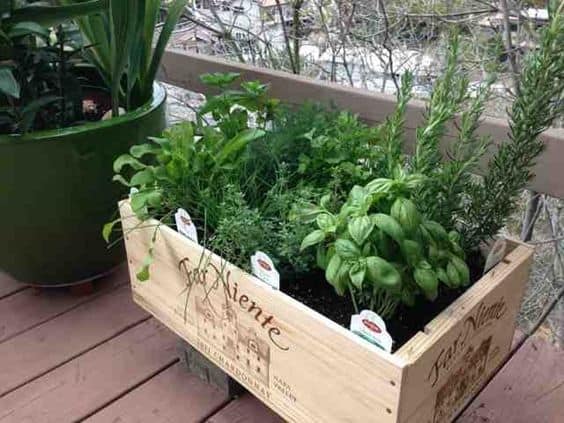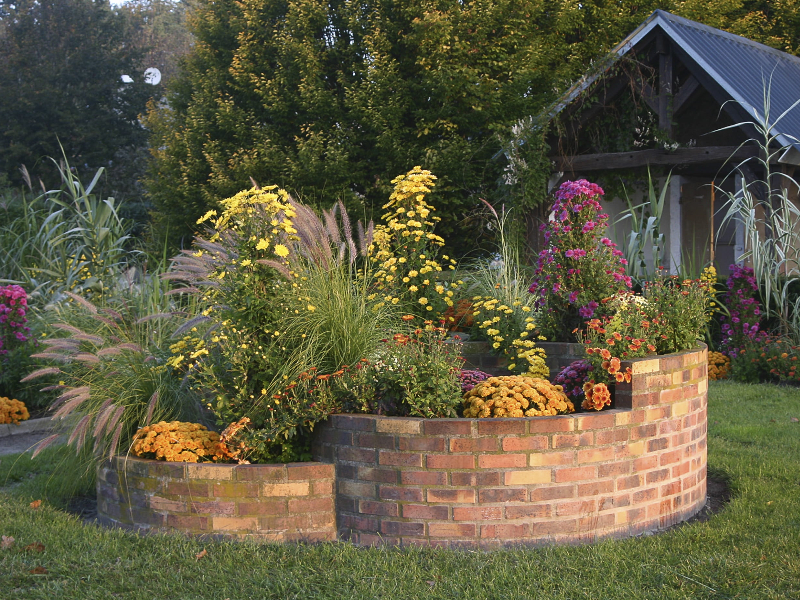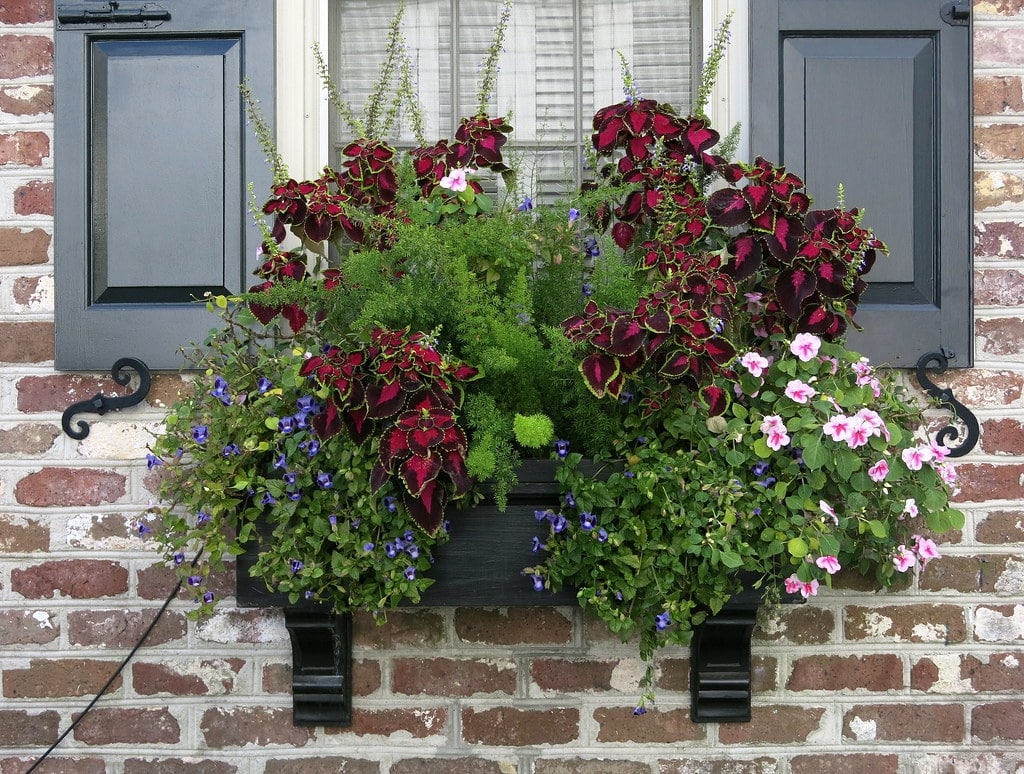Soil is the main provider of nutrients for your plants so it’s important to know each plant’s nutritional requirements before filling a planter box with soil for the first time. The types of soil that are required for specific plants are discussed below but first, let’s look at some soil basics for all planter boxes.

Image credit: @flowerstreetaz
1. Drainage
Rainwater is quickly absorbed by flowerbed plants, meaning their roots are rarely saturated but in a pot or a planter box, the water has nowhere to go. Some plants don’t mind their roots being moist but others hate it. For this reason, it’s a good idea to add some pebbles, sand or eggshells to the bottom of your planter box to aid drainage.
This is really important for herbs, squashes and flowers although cucumbers might be happy with some extra moisture.
Very few plants I know (apart from rice and mangroves) like to sit in water so make sure your planter box can cope with the water you give it.
2. Fertiliser
It is important to meet the needs of all the plants in the planter box so don’t add manure or fertiliser for one plant hoping that another won’t notice!
- Some herbs grow well in sandy soil whereas if you’re growing cucumbers or tomatoes, they crave rich soil with added humus. Adding manure is perfect for these plants.
- Roses and other hungry flowers will be delighted with manure-rich soil too.
- If manure is added to carrots, the roots will fork out in search of nutrients so this is not recommended. Check what you are planting and adjust the soil to suit those plants.
- Cabbages love to be planted in the soil after a crop of beans because they enjoy the nitrogen-rich soil that the beans leave behind.
3. Soil compaction
Over time, the soil in pots and planter boxes becomes compacted, making it difficult for the roots to spread easily or for new seeds to emerge from the soil. You can keep adding a new layer of mulch to planter boxes so that plants always have good soil to feed them. Another idea is to completely change the soil every 2 years.
Also, consider the water that you use for watering your potted plants. Like all indoor plants, the water used has an impact. Chlorinated tap water often leaves a visible salt residue on the soil over time.
Try to avoid this by using collected rainwater or distilled water. That way, your plants are getting watered as if they are in the wild and most of them will thank you for it. Set up a water butt to collect rainwater if you can.

Collect rainwater in a water butt. Image credit: @longhillcarriage
Which soil mix is best for plants in a planter box?
If you are planning to grow roses in your planter box, then your soil mix will be very different to the soil needed for herbs.
Plants that need deep, rich soil with manure and plenty of organic matter include:
- Roses, wisteria and dahlias.
- Vegetables like tomatoes, cucumbers, beans, peas, aubergines, and squash.
- Fruit shrubs and trees such as strawberries, raspberries, and cherries.
Hydrangeas need acidic soil to thrive. Try adding some wood ash, leaf mould, lime or homemade compost to change the PH level for acid-loving plants, including blueberries which need ericaceous (acidic) soil.
Some plants, like nasturtiums, will thrive in poor soil with few nutrients and not much water. Herbs like rosemary and thyme and a range of wildflowers prefer sandy, loose soil and aren’t too fussy about the richness. So check the requirements of each plant and decide if you need to divide the planter into sections before choosing the soil for a planter box.

Photo by Jonathan Kemper on Unsplash
Do I need to add fertiliser to my planter box?
Some plants in your planter box will require extra feeding as they grow while others are happy to use whatever soil is available. Wisteria and roses benefit from a regular feed as do tomatoes and aubergines but other plants can be almost neglected and will survive just fine without feeds.
You can aid the hungriest plants by providing slow-release fertiliser in capsules in the soil. You can also add nutrients naturally by placing some comfrey leaves in the soil when you plant. These leaves are super fertilisers, releasing calcium, iron, potassium, magnesium, vitamin B12 and trace elements as they break down, benefitting the health of your plants over a long period of time.

Well fed plants are happy plants! Image credit: @les.vos
Other natural feeds can be made by using the weeds in your garden! You can make feeds by placing the leaves of the weeds in water and allowing them to settle for 4-5 weeks. Then just add the solution to your watering can to give your hungriest plants a boost.
Aubergine plants love some natural fertiliser, particularly when in flower, so nourish their gorgeous purple flowers with your homemade concoctions. Any younger gardening enthusiasts can be taught about chemistry while you do this!
Other “weeds” which make excellent plant fertilisers include plants you’ll find growing happily in your garden. See the nutrients they provide in the list below. Free feed and weed, what’s not to like?
Natural plant fertilisers
To make ‘weed tea’, soak the chopped leaves of the below nutrient-rich plants in water for up to 4 weeks and add the sieved water to your plants as an effective natural food:
Chicory: calcium, potassium, magnesium
Coltsfoot: calcium, copper, iron, potassium, magnesium
Comfrey: calcium, iron, potassium, magnesium and vitamin B12
Dandelion: calcium, copper, iron, potassium and phosphorus
Meadowsweet: calcium, iron, magnesium and phosphorus
Nettles: calcium, copper, iron and potassium
Plantains: calcium, copper, iron, potassium, and magnesium
Silverweed: calcium, copper, iron, potassium, and magnesium
Vetches: copper, potassium and phosphorus
Watercress: calcium, iron, potassium, magnesium and phosphorus
A word of warning about feeding; many plants will grow more foliage than flowers when they are fertilised so if you are hoping for flowers, check the plant labels first. Nasturtiums produce hundreds of flowers in impoverished soil but if you feed them, they turn their efforts to producing an abundance of leaves rather than flowers.

Use the weeds from your garden to feed your plants. Image credit: @the.indie.elf
What soil mix will suit herbs in my planter box?
Gardeners often choose to place their herbs in one place, making it convenient for the kitchen. It’s also relaxing to watch the bees on flowers and enjoy the aromatic scents. Place your herb planter box in a location where you can enjoy it.
In a planter box, it’s important to remember that different herbs prefer distinct types of soil and also that the aromatic scent from sage, for example, can cause other nearby plants to fail. With this in mind, see suggestions for soil suitable for annual, biennial, and perennial herbs below.
- Annual herbs that grow well together include parsley – flat-leaved and moss curled types (both need rich soil and lots of sunlight), coriander, strawberries, chives, tomatoes, and cucumbers. Add compost and manure to these plants if available. You can add feed when they are flowering and fruiting.
- Biennial herbs such as chervil and caraway can be treated as annuals but you may want to mulch the soil over winter to allow its goodness to penetrate and provide some protection from weeds taking root.
- Perennial herbs like sage, rosemary, thyme, and lovage tend to grow larger than annuals with woody stems. Lavender grows really well with some of these but it is important to make sure that sage is placed at a distance from the others, space permitting. Strawberries and borage are great companions for sage.

Consider planting herbs in different soils for best results. Image credit: @small_garden_big_ideas
Can I add household waste to my planter box?
Adding leftovers to your plants can be worthwhile and help reduce the amount of landfill waste. Experienced gardeners may tell you casually that adding eggshells here and coffee grounds there will give fantastic results.
Some items listed below are recommended but only in small amounts. If you place a week’s supply of tea bags onto one plant, you may kill it off with your kindness! Adding any of these items to your compost bin is always a good idea, where they will decompose slowly adding richness and nourishment for plants in a balanced combination.
- Coffee grounds are full of nutrients and are great to add to indoor plants once in a while but not every day as they may change the acidity of the soil.
- Teabags can be split open after use, then added to geraniums, tomatoes and roses.
- Banana skins are very rich and they attract slugs, so this is a great use for them. Once your target has arrived, place the skin in your compost bin.
- Eggshells add keratin to compost and some swear that slugs and snails are deterred by them. My own experience is watching the pests leave slimy trails over the eggshells en route to the plant I am trying to protect. I would crush eggshells into small pieces and add them to the compost heap instead.

Use coffee grounds sparingly in your garden. Image credit: @gardening.with.ingrid
Choose peat-free soil
If you are buying soil for your planter box from a garden centre, always choose the peat-free varieties. Conserving vital peatlands is essential in the fight to combat climate change. Peatlands store carbon, help to prevent flooding and provide homes for animals. You can read more about how you can go peat-free here.

Save this pin for later






